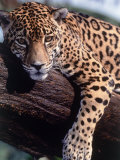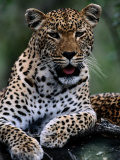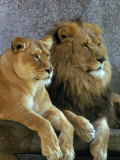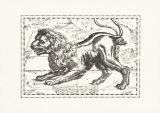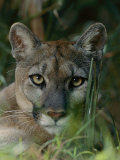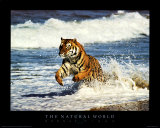|
|
Big Cats Educational Posters & Prints
for the classroom; theme decor for home and office.
|
social studies > animals > cats | BIG CATS | cats in art < mammals < zoology < biology < science
|
|
The genus Panthera in the family Felidae, is the “big cats” - the Tiger, Lion, and Leopard in the Old World, and the Jaguar in the New World. Other big cats are the caracal, cheetah, cougar (aka puma and mountain lion), lynx, ocelots, and serval.
|
|
The caracal (Caracal caracal), from the Middle East and Africa is a fiercely territorial medium-sized cat whose name comes from the Turkish word karakulak, meaning “black ear”.
Though now believed to be more closely related to the African golden cat and the Serval, it has been known in the past as the Persian, Egyptian and African Lynx.
|
|
|
|
The cheetah, Acinonyx jubatus, the fastest land animal, is capable of reaching speeds of 70-75 mph over short distances, prefer hunting in open spaces such as grasslands, though it can be found in mountainous terrain and areas of dense vegetation of Africa and Asia.
Historically cheetahs, whose name is from the Sanskrti citrakayah, have been tamed as used as hunting companions.
|
|
|
|
The cougar, Puma concolor, is a solitary predator with a range from the Canadian Yukon to the southern Andes Mountains.
FYI - Because of the cougar's extensive range it holds the Guinness record for the highest number of names, including puma and mountain lion.
Did you know that the political and sacred capital of the Inca Empire, Cuzco, is thought to be laid out in the shape of the puma?
|
|
|
|
Jaguar, Panthera onca, is one of the big cats in the Panthera genus, and the only one found in the New World, preferring rainforest habitats, such as Belize.
The jaguar’s fur is generally tawny yellow and covered with multishaped rosettes that may be filled with dots. The jaguar is an important symbol source in Mayan and Aztec mythology, and the national animal of Brazil.
|
|
|
|
Leopard (Panthera pardus), the smallest of the ‘big cats’, is on the ‘near threatened’ list.
The nocturnal leopard’s fur, rosettes without internal spots, serves as camouflage during the day, when at rest.
The name leopard is a portmanteau from the Greek combining lion and panther, based on the belief that a leopard was a hybrid of a lion and panther.
FYI - Did you you that dancer/actress Juliet Prowse was mauled twice by the same leopard?
|
|
|
|
Lion, Panthera leo, is the second largest cat after the tiger, and one of the most recognized symbols in human culture.
Lions were the most widespread large land mammal, besides the human, until about 10,000 years ago. Currently lions live in Sub-Saharan Africa with a ‘critically endangered’ remnant in northwest India, having disappeared from North Africa, the Middle East, and Western Asia within historic time.
|
|
|
|
Lynx have short tails, tufts of black hair on the tips of their ears, a black ruff at their throat and large padded paws. There are four species of wild big cats called lynx ranging across the northern hemisphere in North America, Europe and Asia: Lynx canadensis, Lynx rufus (bobcat), Eurasian Lynx (Lynx lynx) and Iberian Lynx (Lynx pardinus) which is nearly extinct.
In mythology lynx are associated with keen eyesight, stealth, and the Argonaut Lynceus.
|
|
|
|
Ocelot (Leopardus pardalis), a wild cat ranging over South and Central America and Mexico is similar in appearance to domestic cats. Because the ocelots fur was regarded as valuable hundreds of thousands have been killed and the ocelot was classified an endangered species from 1972 until 1996. The ocelot is now rated “least concern” by the 2008 International Union for the Conservation of Natural Resources (IUCN) Red List, the world's most comprehensive inventory of the global conservation status of plant and animal species.
|
|
|
|
The Florida Panther, the state animal of Florida, is “a large, long-tailed, pale brown cat that grows to six feet or longer”. Human population and development threaten the existence of the panther's natural habitats and range.
|
|
|
|
Servals, Leptailurus serval, live in the African savannas and are thought to be “the most effective and successful hunter of all mammals in the animal kingdom.” They have the longest legs of all cats, (relative to body size) and large ears with acute hearing to locate small prey.
|
|
|
|
Tiger, Panthera tigris, is the largest of the four “big cats”. Tigers range from the Siberian taiga biome above the Arctic tree line to tropical swamps. Out of nine subspecies of tiger, three are extinct and six are classified as endangered.
Tigers are recognizable for their black stripes which range from base coat of white to rusty red to rusty brown.
The Royal Bengal Tiger is the national animal of India.
|
|
previous page | top | cats | BIG CATS | cats in art
|
|
I have searched the web for visual, text, and manipulative curriculum support materials - teaching posters, art prints, maps, charts, calendars, books and educational toys featuring famous people, places and events - to help teachers optimize their valuable time and budget.
Browsing the subject areas at NetPosterWorks.com is a learning experience where educators can plan context rich environments while comparing prices, special discounts, framing options and shipping from educational resources.
Thank you for starting your search for inspirational, motivational, and educational posters and learning materials at NetPosterWorks.com. If you need help please contact us.
|
|
|














